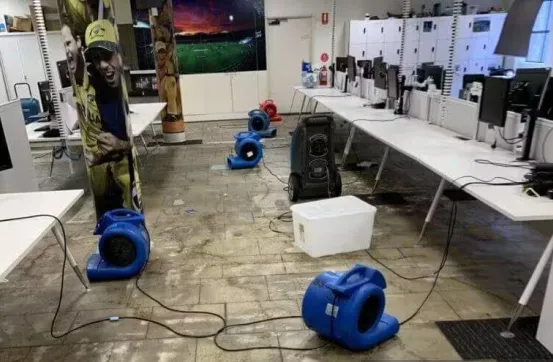Water damage is one of the biggest challenges for businesses, as it can occur suddenly and have significant, expensive consequences. Even small leaks, whether caused by broken pipes, flooding storms, or malfunctioning appliances, can swiftly turn into major problems. Commercial properties in Australia are especially vulnerable to water damage due to the country’s unpredictable weather and seasonal downpours. In addition to the obvious mess, untreated water damage can result in mold growth, structural deterioration, and health risks for both staff and clients.
Also Read: How Car Dealerships Help Drivers Find The Right Vehicle?
In such situations, engaging expert water damage restoration providers, such as the highly skilled Squeaky Clean Team, ensures companies recover quickly, preserve valuable assets, and maintain business continuity. This article will serve as a comprehensive guide on to Australian businesses, offering case studies that underscore the critical importance of relying on professionals, like Squeaky Clean Team.
How Water Damage Disrupts Australian Businesses: Risks and Consequences
Although water damage can happen promptly, it is often linked to preventable causes. For instance, it is frequently caused by burst or leaky pipes, blocked gutters, drainage issues, roof leaks during storms, defective kitchen appliances, sewage overflow, and natural flooding due to heavy rains or coastal overflows. Business owners can proactively address the concerns and reduce the damage by being aware of these issues.
Water damage has a significant impact on businesses beyond visible puddles and wet carpets. In addition to deteriorating structural elements, such as flooring, walls, and ceilings, moisture can also compromise electrical systems, thereby increasing the fire risk in the building. Within 24 to 48 hours, the mold development becomes a health hazard.
There is a risk of incurring costly losses in inventory, equipment, and stock, and business inactivity can lead to lower profits and unhappy clients. Professional action is critical, as delays can significantly impact continuity and property value.
Why Businesses Need Professional Water Damage and Restoration Services
Some business owners may attempt DIY clean-ups, but water damage is rarely limited to the surface. Moisture often seeps into walls, floors, and foundations, creating hidden risks that only professionals can address. Always choose a trusted water damage restoration company!
Key Benefits of Hiring Experts:
- Quick Response: Experts respond fast, minimizing downtime and speeding business recovery.
- Specialized Equipment: Professionals use advanced tools for thorough drying and effective restoration.
- All-inclusive Solutions: Beyond water removal, experts repair affected areas and restore indoor air quality.
- Mold Prevention: Specialists apply treatments that proactively stop mold and protect health.
- Insurance Support: Restoration pros help document damage, making insurance claims easier and faster.
By working with experts, businesses can ensure that their workplace is completely dried, sanitized, and operationally safe.
Questions to Ask Before Hiring a Restoration Company
Businesses must hire the right company when dealing with water damage restoration and carpet flooding. They should ask the following essential questions:
- Do you dry carpets using a float drying method?
- How quickly can they dry wet carpets?
- Do you offer aid with insurance?
- What kind of equipment do you use professionally?
Any restoration company without air movers, moisture meters, or dehumidifiers is a warning sign. Professionals are always ready to serve with advanced technology for carpet water damage.
Why Choose Expert Restoration Teams Like Squeaky Clean Team?
Squeaky Clean Team answers all the above questions. Selecting a reputable company, like Squeaky Clean Team, when water damage occurs, guarantees that your business receives prompt and expert assistance. With years of experience throughout Australia, they respond around the clock to minimize downtime and protect assets.
They handle everything from comprehensive repairs to water damage and carpets using advanced drying equipment and restoration processes. Their professionals also help with insurance claims, facilitating a stress-free and easy recovery. To get your property back to normal, contact Squeaky Clean Team today and let their experts take care of the restoration process for you.
The Process of Water Damage and Restoration
For Squeaky Clean Team, professional restoration is a methodical process, designed to save businesses and ensure that nothing is overlooked. Below is the process of water damage and restoration:
1. Inspection and Assessment
The first step for experts is to detect the water intrusion point and evaluate the water quality (clean water, grey water, or black water). It identifies the risk degree and the methods used during the restoration process.
2. Water Extraction
By using industrial-grade pumps and vacuums, they quickly remove standing water. This is important to prevent further seepage into walls, flooring, and furniture.
3. Drying and Dehumidification
They use air movers and dehumidifiers to remove moisture trapped in building materials, such as carpets. Specialists also use moisture meters to monitor the progress and ensure the final drying is complete.
4. Cleaning and Sanitization
Restoration specialists thoroughly clean and sanitize the affected areas to eliminate bacteria, mold, and unpleasant odors, making the workplace hygienic.
5. Repairs and Restoration
The final step is to repair or replace damaged ceilings, floors, or walls. The goal is to restore the business to its pre-damage state as quickly as possible.
Case Studies- Water Damage Incidents in Cricket Australia’s Melbourne Office
Squeaky Clean Team offered fast restoration when Cricket Australia’s Melbourne Office had water damage in its building. Their specialists controlled the process of water extraction, water damage carpet drying, and mold prevention using modern equipment.
The rapid action reduced the downtime, saved precious assets, and returned the workplace to its productive operations, ensuring hassle-free business continuity.

Incident 1: 2017 – Broken Pipe Flooding
Date & Cause
In Cricket Australia’s Melbourne Office, a pipe in the toilets on the third floor burst in June 2017, allowing water to flood through the ceilings and over three floors, damaging the structure and the contents.
Timeline & Restoration Work
| Day | Key Activities |
| Day 1 | Quick extraction deployment: A team of 7 specialists started the project by clearing accumulated water and starting mitigation. Water removal from impacted flooring and carpets. Evaluation of the structural damage, ensuring that water-damaged carpet areas are fixed. |
| Days 2–3 | Structural repairs started: The structural repairs began with the evaluation and restoration of the walls and ceilings. Lowered humidity by the use of drying equipment (dehumidifiers, air movers). Installed machinery to dry wet flooring and carpet, and tracked the amount of moisture. |
| Day 4 onward | Drying and monitoring continued: Selected between removing damaged carpet tiles and drying wet carpet in place. In this instance, damaged sections were dried, and structural components were restored to save time and guarantee quality. |
| Conclusion | Complete recovery with the least amount of operational interruption: Even though the office was affected by water damage, Cricket Australia continued to operate during the height of international cricket coverage. |
Client Outcome
- Despite the crisis, Cricket Australia continued to operate without relocating its employees.
- With little downtime, structural and aesthetic damage was fixed.
- Where the carpet damage was not extensive, they applied wet dry carpet treatments, while where the carpets were seriously damaged, they replaced the damaged portions to restore them.
Incident 2: 2020 – Burst Hot Water System
Date & Cause
A hot water system failed in April 2020, flooding over 370 square meters of Cricket Australia’s East Melbourne headquarters. The Squeaky Clean Team quickly started the restoration project.
Timeline & Restoration Work
| Day | Activities & Process |
| Day 1 | Over 350 m² of water were extracted as an immediate response. At first, the humidity was excessive, at about 70%. 13 air movers and 7 dehumidifiers were deployed. They removed water quickly to stop additional damage. |
| Days 2-4 | To speed up drying, extra equipment was added, including 30 air movers and 12 additional dehumidifiers. Humidity is monitored daily; it steadily drops to around 40%. |
| Day 6 | Treated Carpet flooding. Damaged carpet tiles were removed and disposed of, confirming that the subflooring was dry and prepared for the following phase. Emphasized being well-prepared to prevent problems in the future. |
| Day 7 | Final observation verified that drying goals were met. New floor tile installation preparations were made. Completed reputation restoration for Cricket Australia, along with water damage restoration. |
Client Outcome
- The restoration process took approximately 7 days to complete. Without having to relocate employees, Cricket Australia could resume regular operations.
- Wet carpet drying was completed for the remaining space, and damaged carpet tiles were replaced. The interior and structure sustained no long-term damage.
- The project demonstrated excellent collaboration, minimal disturbance, and adherence to expert water damage restoration standards.
Takeaways for Business and Property Managers
Based on the case studies of Cricket Australia, property managers and business leaders can learn several lessons on how to better prepare for and respond to water damage incidents and mitigate the damage in such cases. These facilitate streamlining responses, ensuring safety, property maintenance (including carpets, walls, and ceilings), and business continuity.
· Early Detection and Prompt Action are Important
According to the 2020 Cricket Australia case, the use of instant water extraction and prompt drying equipment installation significantly reduces damage. Static water can lead to mold growth, structural damage, decay of wet carpet, and carpet flooding.
· Use Appropriate Equipment & Scale of Response
Try using flooded carpet drying treatments, dehumidifiers, air movers, and extraction tools. Restoration operations that lack sufficient resources slow down the drying process, leading to increased material degradation and higher costs. For immediate and expert support during water damage, contact a trusted restoration provider today.
· Monitor Humidity and Moisture Consistently
Restoration experts verify that the drying process must be done everywhere. Without monitoring every space, you may think that everything is dry, but there is water under the floorboard, wall, or carpet. It is dangerous not only for business elements but also for the property structure.
· Decide When to Remove vs. Restore Carpets or Flooring
There are cases where wet dry carpet methods are sufficient. In other instances, saturated carpet tiles or underlay must be removed to avoid continuous problems. Hence, in both cases, the damaged carpet tiles were required to be removed.
· Concentrate on Business Continuity
The restoration of Cricket Australia’s Melbourne office meant that work would not stop even when international cricket was being covered. Good planning, coordination, and quick restoration work imply that operations do not have to close down entirely.
· Communication with Stakeholders
The tenants, personnel, building management, and restoration teams should all be in line. Squeaky Clean Team acted in cooperation with a responsive client. Clear communication in processes, schedules, and expectations can prevent stress and conflict.
· Ensure Proper Finish & Follow-up
Flooring, carpets, tile placement, and repair of ceiling/walls should be well done after drying. Observation after the restoration is also a way to ensure that mold or odor is not produced due to the presence of any concealed moisture.
· Maintenance and Prevention
Frequently inspect hot water systems, plumbing, roof flashing, and piping to reduce the chance of leaks and bursts. Regular inspections may prevent incidents similar to those in 2017 and 2020, which occurred at Cricket Australia’s Melbourne Office.
Preventing Water Damage in Commercial Properties
Experts are available in times of crisis, but prevention is always preferable to treatment. Australian businesses can practice proactive risk-reduction strategies:
Routine Inspections: Expert evaluations uncover concealed weaknesses.
Routine plumbing maintenance: Fix leaks and replace aging pipes.
Gutter and roof checks: Remove any debris to prevent overflowing stormwater.
Waterproofing walls and basements: this is crucial in areas vulnerable to flooding.
Setting up water alarms: Find leaks before they get out of control.
Businesses can protect their premises and minimize downtime by partnering with reputable restoration companies, such as Squeaky Clean Team, and implementing preventive measures.
Conclusion
Water damage is undoubtedly one of the biggest threats that Australian businesses usually face. Structural damage, mold growth, and wastage of time are some of the risks involved with water damage. However, the Squeaky Clean Team is ready to offer its skills, machinery, and prompt action to save Australian business premises from water damage. Through quick response, professionals not only prevent complete destruction and anticipate future risks, but also save businesses money and reduce the inconvenience caused to their daily routine.
It is obvious to business owners that they should not wait until the water damage gets out of control. The most recommended option is to contact a reputable restoration company that can save your property, staff, and bottom line in the event of any emergency water damage restoration.



